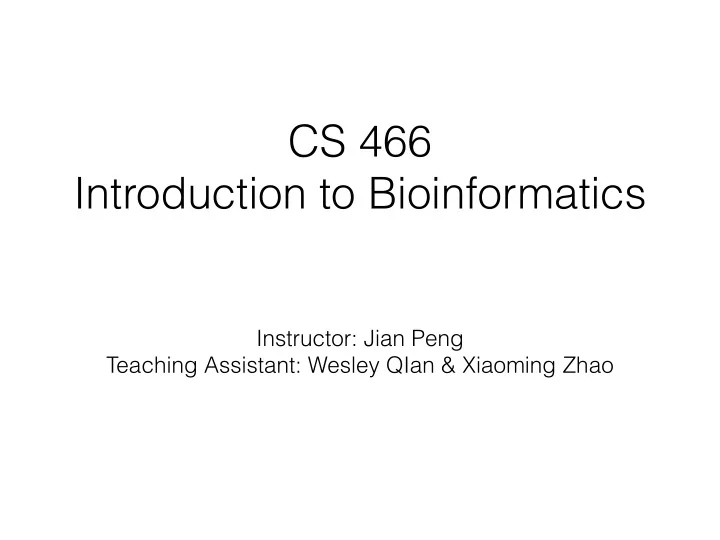

CS 466 Introduction to Bioinformatics Instructor: Jian Peng Teaching Assistant: Wesley QIan & Xiaoming Zhao
Introduction Instructor: • Jian Peng My office location: 2118 SC Office hour: Thu, 2:00pm-3:00pm Email: jianpeng@illinois.edu • My research area: Computational Biology and Machine Learning Teaching Assistants: • Wesley Qian, PhD student (weiqian3@illinois.edu) Office hour: TBD • Xiaoming Zhao, PhD student (xz23@illinois.edu) Office hour: TBD
Prerequisites • Programming skills (equivalent to CS 225) for doing the mini-project. • Knowledge of basic probability and statistics for understanding several lectures. • No biology background is necessary.
Course logistics • Course website: https://courses.engr.illinois.edu/cs466/sp2020/ • Piazza website: https://piazza.com/illinois/spring2020/cs466/home • Lecture slides will be released before each class. • Participation is encouraged. • Come to class having read the day’s lecture slides and reading assignments, if any.
Course Objectives Introduction to bioinformatics • Basic problems in computational biology • Statistics and machine learning for data analysis • Algorithms for data processing Learning to do research • Course project experience • Hands-on practice with real datasets • Propose and perform independent research
Grading For 3-credit students • Five problem sets (30%) • Midterm (25%) • Final (25%) • Team-based mini-project and report (20%) For 4-credit students • Five problem sets (20%) • Midterm (25%) • Final (25%) • mini-project + individual report (30%)
Assignments • See the University Policy on Academic Integrity, especially the section on plagiarism. • Late submission within 3 days (72 hours) is worth 80% credit. • A student may request an extension of 3 days at most once in the semester.
Course Project Computational techniques • Comparing algorithms • Efficient implementation of algorithms that scale on large datasets • New probabilistic models for biological data Biological problems • Comparative analysis • Interesting data analysis • New computational biological problems
Course Project • Team size • one or two (4-credit students) • up to four (3-credit students) • make clear your contribution in the project report • Implementation • put your code/data on github • get your hands dirty and work on real-world datasets
Grading Data from recent offerings: • Enrollment: 40~70 • ~60% A grades • ~40% B grades This is not a statement about what the distribution of this semester will be.
Questions about the course logistics?
Introduce yourself
Bioinformatics • Is not about one problem (e.g., designing better computer chips, better compilers, better graphics, better networks, better operating systems, etc.) • Is about a family of very different problems, all related to biology, all related to each other • How can computers help solve any of this family of problems ?
Bioinformatics and You • You can learn the tools of bioinformatics • These tools owe their origin to computer science, information theory, probability theory, statistics, etc. • You can learn the language of biology, enough to understand what the problems are • You can apply the tools to these problems and contribute to science
Important Biological Questions? “Why do humans have so few genes?” “Can we understand DNA code?” “Can we understand gene function?” “How did cooperative behavior evolve?” “Can we cure cancer?” ……
What does biological data look like? Sequence data • Protein/DNA sequence • Probabilistic models for sequences • Dynamic programming Matrix data • Gene expression • Dimensionality reduction and feature selection • PCA and clustering
Biological Data Graph data • Molecular interaction networks • Graph algorithms Heterogeneous data • Dimensionality reduction • Probabilistic models for data integration • Network-based data integration
TODO after this class (reading assignment) Please read “Molecular Biology for Computer Scientists” by Lawrence Hunter
Examples of my research projects
Recent research Cell Systems, 2016 Cell Systems, 2017 Nature Communications, 2017 Cell Systems, 2018
Protein sequence, structure and function sequence ACDEEEFGHIKL----MPQRSTVWY ACDE--FGHIKLRMQP----STVWY structure function
Network analysis for disease modeling network analysis new disease biology (potential drug targets) human disease network
Pharmacogenomics and cancer genomics Figure from the DREAM challenge website
Recommend
More recommend